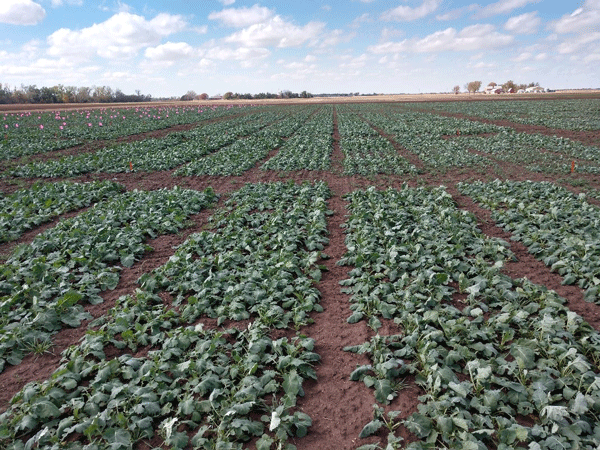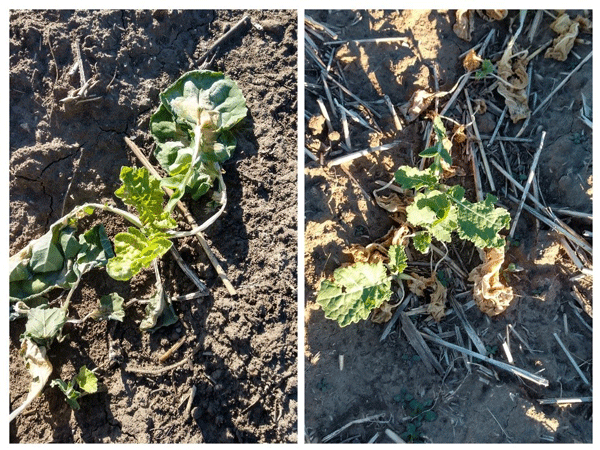Winter canola planting conditions were much improved in the fall of 2023. While much of central Kansas remains at some level of drought intensity, the majority of the canola crop was seeded following timely rains, leading to optimum growth. It will be interesting to see how continued drought will impact overwintering canola. Fortunately, the start of the cold period has been relatively mild. Still, one of the main questions for growers is, how could dry soils and cold temperatures affect the winter survival of canola?
Effect of canola plant size on winter survival
Rapid and timely emergence is critical for attaining the right amount of growth before winter, which we’ve seen this growing season. Canola overwinters -- and is the most tolerant to cold temperatures -- in the rosette growth stage. At this stage, the crown (rosette) develops at the soil surface with larger older leaves at the base and smaller newer leaves at the center. The stem thickens, but its length remains unchanged. To have the best chance at survival, a winter canola plant needs 5 to 8 true leaves, 6 to 18 inches of fall growth, a root collar diameter of ¼ to ½ inch, and an extensive root system.
On the other hand, canola that has too much top growth (typically 24 inches or more) in the fall can succumb to winterkill for a few reasons, including overuse of available soil water and nutrients, stem elongation well above the soil surface, and physical damage to the unprotected crown as winter temperatures arrive.
Crop establishment in 2023
As mentioned, soil moisture conditions made canola establishment much easier in 2023. Most producers were able to plant during the optimum window for their area, while some had to wait as rains were delayed. Canola trials near Manhattan were seeded about two weeks later than optimum, which resulted in less than normal plant development and growth before winter.
An abrupt cold snap around November 1 tested the crop early for cold tolerance. Most canola in central Kansas possessed adequate top growth and were able to handle the cold temperatures with ease. Figure 1 shows winter canola trials planted near Hutchinson with optimum growth in late October. As a result, only minor leaf bleaching and leaf area loss were observed. This is a positive sign because the crop had little time to acclimate to temperatures in the teens before the cold snap.

Figure 1. Winter canola plots near Hutchinson on October 26, 2023. The plots were seeded into good soil moisture on September 14, 2023. Photo by Mike Stamm, K-State Research and Extension.
Stand loss from early cold temperatures was a greater risk near Manhattan because the canola plants were not as far along in development as a result of late planting. Figure 2 shows how plants looked shortly after the hard freeze and two weeks later. Fortunately, the crowns remained firm and turgid after the hard freeze. This is a good indication that plants were not lost. After a couple of weeks of above-normal temperatures, canola plants added new leaves at the center of the rosette, and the frozen leaves withered away. If temperatures had remained below normal for an extended period, we would have expected significant stand loss; however, the warm temperatures helped the plants rapidly recover. Plants that were delayed in development caused by uneven emergence were lost due to the cold temperatures; some minor stand thinning was observed.

Figure 2. Winter canola plants near Manhattan, KS. The picture on the left was taken November 3, 2023, and the picture on the right was taken November 17, 2023. Notice how the bleached and wilted leaves on the left eventually turned brown and were lost. New leaf growth is evident at the center of the rosette on the right. The plots were seeded on September 25, 2023. Photos by Mike Stamm, K-State Research and Extension.
It will be interesting to see how well these plants handle future cold temperatures, especially near Manhattan. The good news is that plants are in a great period for cold temperature acclimation. Ideally, days with highs in the 40s and nighttime lows in the 20s will prepare canola for harsher winter temperatures. Also, a warmer than normal winter will benefit crops with less aboveground biomass that are at greater risk for winterkill. Areas that are still facing drought conditions are more prone to winterkill due to both cold and dry conditions, which are typically more precarious than cold and wet conditions.
For producers concerned about the effects of cold temperatures this time of year, visit canola fields about five days after the hardest freeze event. Look for bleached (whitened) leaves, wilted plants, and dead plants (dry and brown). Pull up plants to squeeze and inspect the root and crown for firmness and turgidity.
In next week’s e-Update, we will explore other factors affecting winter survival and discuss current research.
For additional information on canola production, please refer to the recently revised “Great Plain Canola Production Handbook,” available through K-State Research and Extension. https://www.bookstore.ksre.ksu.edu/pubs/MF2734.pdf
For more information about canola growth and development stages, please consult the K-State Canola Growth and Development poster: https://www.bookstore.ksre.ksu.edu/pubs/MF3236.pdf
Mike Stamm, Canola Breeder
mjstamm@ksu.edu
Ignacio Ciampitti, Farming Systems
ciampitti@ksu.edu
Tags: canola winter survival winter canola stand establishment